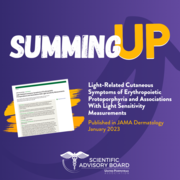The United Porphyrias Association is proud to work closely with the porphyria experts on the UPA's Scientific Advisory Board and at the Porphyrias Consortium.
We're pleased to introduce our Experts in Action where we'll feature:
Sign up to never miss a feature!

"You have to figure it out for your own body and trust that you know your body better than anybody else. I think that's where having a community of other patients and patient advocates is important because it can give you that confidence, security, friendship, and empathy that you're doing what's right for you."

From chronic pain, impacts on mental health, limitations to employment, the POWER study captures the realities of living with acute hepatic porphyria from patients around the world.

Question: If you have acute porphyria, why is it important to have your liver function checked annually? What can you do to prevent issues with your liver?

"It’s been really eye-opening to see how important patient involvement is in rare disease. Patients can drive the field, move the field. Rare diseases like porphyria are very life-altering. Patients have an important role in how the regulatory agencies and how physicians are looking at the disease and what the outcomes are."

Liver dysfunction is a rare but very real possibility for people with EPP and XLP. These guidelines provide recommendations for the diagnosis, monitoring and treatment of liver-related dysfunction in protoporphyrias (EPP and XLP).

"My connection to porphyria is a bit more personal than a lot of other researchers. I have EPP porphyria."

In this Summing UP, researchers looked at 28 years of medical records to identify if women with AHP and their babies were at increased risk of pregnancy complications.

Question: I have AIP. I haven’t had a porphyria attack for several years and I don’t have a porphyria specialist. Is there anything I should ask my doctor to check for during my annual check-up?

"Seeing patients and how it impacts them day-to-day, and how their families' lives are impacted, it’s a different level of understanding."

This research describes some important features of EPP including prodromal (warning) symptoms, a priming effect from previous light exposure, and lack of visible symptoms among many patients.